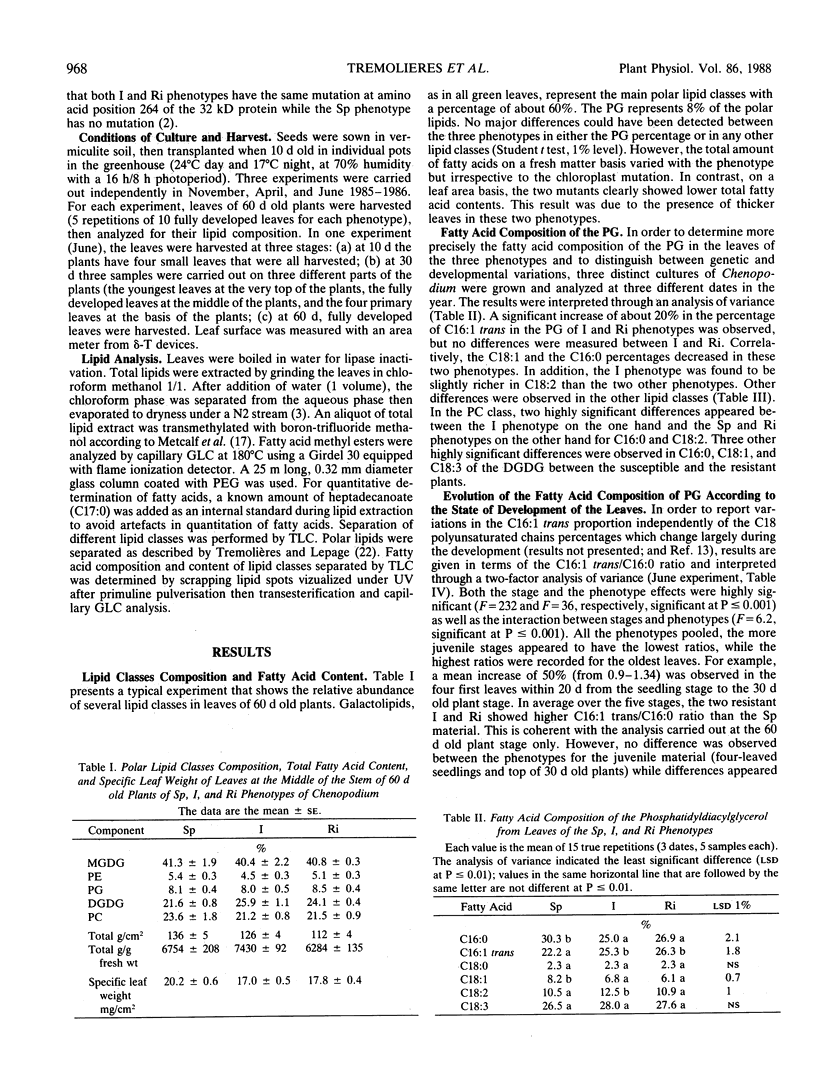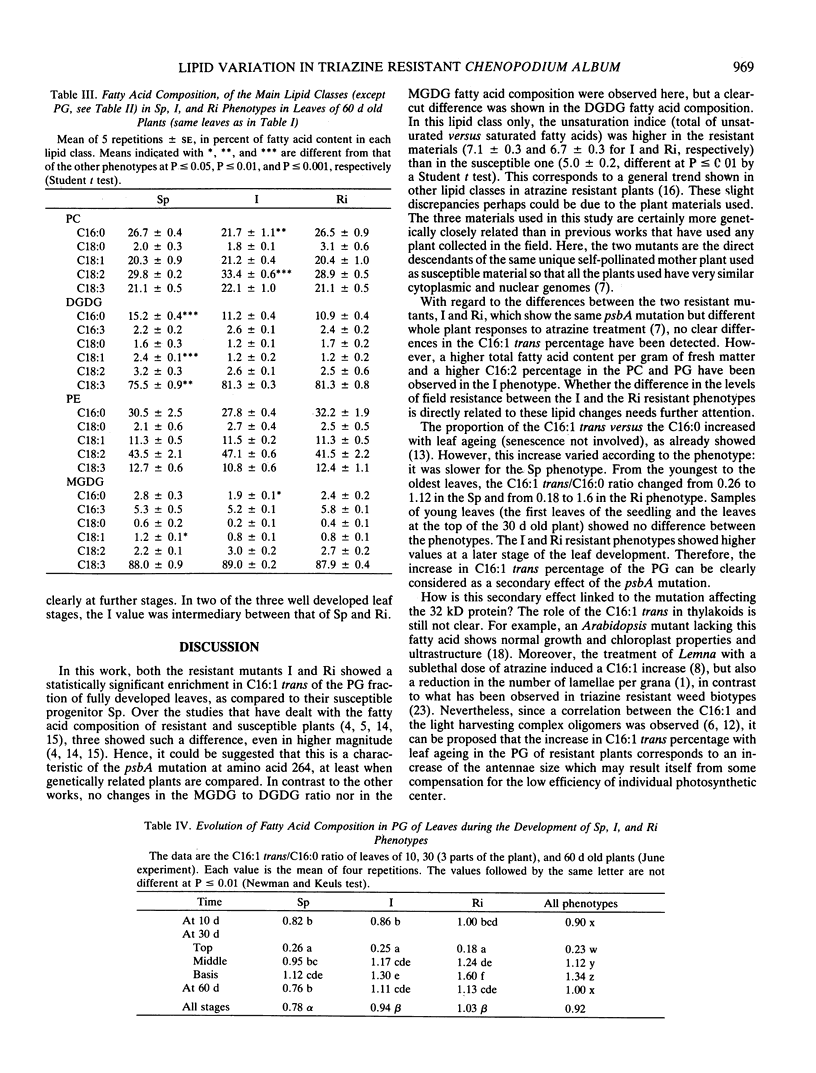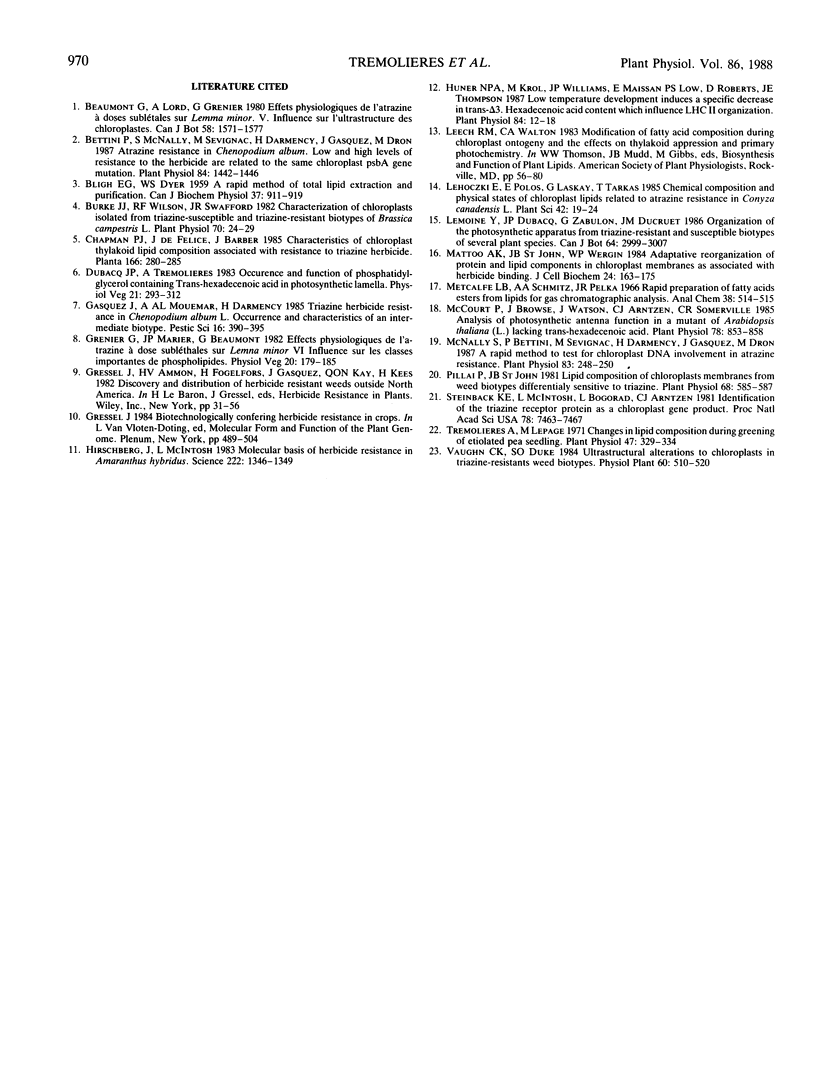Abstract
Two atrazine resistant nutants of Chenopodium album L. and their susceptible progenitor were analyzed for lipid composition. In the phosphatidyldiacylglycerol the Δ3-trans-hexadecenoic acid (C16:1 trans) percentage was higher in the two resistant phenotypes. However, this difference appears later in the development of the leaves and is not clearly observed in young leaves and seedlings. Thus, the increase of the C16:1 trans during the leaf development of the resistant phenotypes is probably a secondary effect of the psbA mutation that arises in compensation for some photosynthesis deficiency. The significance of the lipid differences shown between the two resistant mutants is discussed in terms of whether they are responsible of the two different levels of herbicide resistance observed in the field.
Full text
PDF



Selected References
These references are in PubMed. This may not be the complete list of references from this article.
- BLIGH E. G., DYER W. J. A rapid method of total lipid extraction and purification. Can J Biochem Physiol. 1959 Aug;37(8):911–917. doi: 10.1139/o59-099. [DOI] [PubMed] [Google Scholar]
- Bettini P., McNally S., Sevignac M., Darmency H., Gasquez J., Dron M. Atrazine Resistance in Chenopodium album: Low and High Levels of Resistance to the Herbicide Are Related to the Same Chloroplast PSBA Gene Mutation. Plant Physiol. 1987 Aug;84(4):1442–1446. doi: 10.1104/pp.84.4.1442. [DOI] [PMC free article] [PubMed] [Google Scholar]
- Burke J. J., Wilson R. F., Swafford J. R. Characterization of Chloroplasts Isolated from Triazine-Susceptible and Triazine-Resistant Biotypes of Brassica campestris L. Plant Physiol. 1982 Jul;70(1):24–29. doi: 10.1104/pp.70.1.24. [DOI] [PMC free article] [PubMed] [Google Scholar]
- Hirschberg J., McIntosh L. Molecular Basis of Herbicide Resistance in Amaranthus hybridus. Science. 1983 Dec 23;222(4630):1346–1349. doi: 10.1126/science.222.4630.1346. [DOI] [PubMed] [Google Scholar]
- Huner N. P., Krol M., Williams J. P., Maissan E., Low P. S., Roberts D., Thompson J. E. Low Temperature Development Induces a Specific Decrease in trans-Delta-Hexadecenoic Acid Content which Influences LHCII Organization. Plant Physiol. 1987 May;84(1):12–18. doi: 10.1104/pp.84.1.12. [DOI] [PMC free article] [PubMed] [Google Scholar]
- Mattoo A. K., St John J. B., Wergin W. P. Adaptive reorganization of protein and lipid components in chloroplast membranes as associated with herbicide binding. J Cell Biochem. 1984;24(2):163–175. doi: 10.1002/jcb.240240207. [DOI] [PubMed] [Google Scholar]
- McCourt P., Browse J., Watson J., Arntzen C. J., Somerville C. R. Analysis of Photosynthetic Antenna Function in a Mutant of Arabidopsis thaliana (L.) Lacking trans-Hexadecenoic Acid. Plant Physiol. 1985 Aug;78(4):853–858. doi: 10.1104/pp.78.4.853. [DOI] [PMC free article] [PubMed] [Google Scholar]
- McNally S., Bettini P., Sevignac M., Darmency H., Gasquez J., Dron M. A rapid method to test for chloroplast DNA involvement in atrazine resistance. Plant Physiol. 1987 Feb;83(2):248–250. doi: 10.1104/pp.83.2.248. [DOI] [PMC free article] [PubMed] [Google Scholar]
- Pillai P., John J. B. Lipid composition of chloroplast membranes from weed biotypes differentially sensitive to triazine herbicides. Plant Physiol. 1981 Sep;68(3):585–587. doi: 10.1104/pp.68.3.585. [DOI] [PMC free article] [PubMed] [Google Scholar]
- Steinback K. E., McIntosh L., Bogorad L., Arntzen C. J. Identification of the triazine receptor protein as a chloroplast gene product. Proc Natl Acad Sci U S A. 1981 Dec;78(12):7463–7467. doi: 10.1073/pnas.78.12.7463. [DOI] [PMC free article] [PubMed] [Google Scholar]
- Trémolières A., Lepage M. Changes in Lipid Composition during Greening of Etiolated Pea Seedlings. Plant Physiol. 1971 Feb;47(2):329–334. doi: 10.1104/pp.47.2.329. [DOI] [PMC free article] [PubMed] [Google Scholar]


